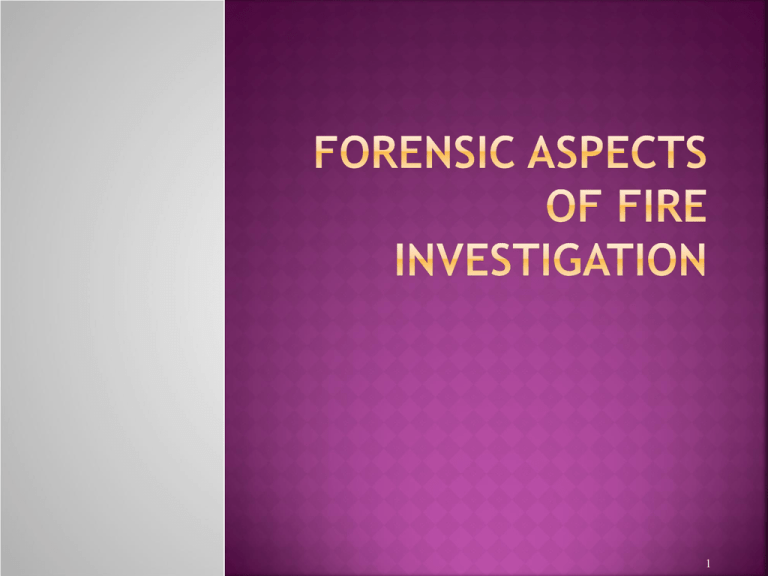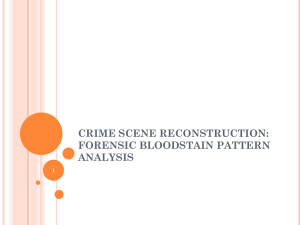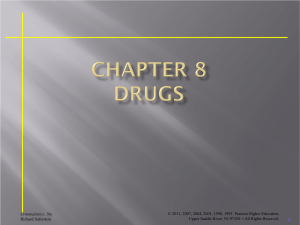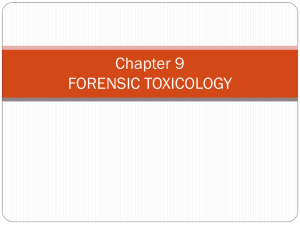
1
Arson
often presents complex and difficult
circumstances to investigate due to the fact that
the perpetrator has thoroughly planned the act, is
not present during the act, and the destruction is
so extensive.
The criminalist’s function is rather limited to
detecting and identifying relevant chemical
materials collected at the scene and
reconstructing and identifying ignitors or
detonating mechanisms.
Criminalistics, 10e
Richard Saferstein
© 2011, 2007, 2004, 2001, 1998, 1995 Pearson Higher Education,
Upper Saddle River,2NJ 07458. • All Rights Reserved.
14-
Chemically,
fire is a type of oxidation, which
is the combination of oxygen with other
substances to produce new substances.
To start fire, the minimum temperature
needed to spontaneously ignite fuel, known
as ignition temperature, must be reached.
The heat evolved when a substance burns is
known as heat of combustion.
An additional factor, besides the liberation of
energy, needed to explain fire is the rate or
speed at which the oxidation reaction takes
place.
Criminalistics, 10e
Richard Saferstein
© 2011, 2007, 2004, 2001, 1998, 1995 Pearson Higher Education,
Upper Saddle River,3NJ 07458. • All Rights Reserved.
14-
A
fuel will achieve a reaction rate with
oxygen sufficient to produce a flame only
when it is in the gaseous state.
A liquid burns when the temperature is high
enough to vaporize it (flash point), while a
solid must be hot enough to decompose into
gaseous products (pyrolysis).
Glowing combustion or smoldering is burning
at the fuel-air interface, such as a cigarette.
Spontaneous combustion, which is rare, is
the result of a natural heat-producing
process in poorly ventilated containers or
areas.
Criminalistics, 10e
Richard Saferstein
© 2011, 2007, 2004, 2001, 1998, 1995 Pearson Higher Education,
Upper Saddle River,4NJ 07458. • All Rights Reserved.
14-
The
arson investigator needs to begin
examining a fire scene for signs of arson as
soon as the fire has been extinguished.
Experience shows that most arsons are
started with petroleum-based accelerants.
The necessity to begin an immediate
investigation even takes precedence over the
requirement to obtain a search warrant.
The search of the fire scene must focus on
finding the fire’s origin, which may be most
productive in any search for an accelerant or
ignition device.
Criminalistics, 10e
Richard Saferstein
© 2011, 2007, 2004, 2001, 1998, 1995 Pearson Higher Education,
Upper Saddle River,5NJ 07458. • All Rights Reserved.
14-
Some
telltale signs of arson include evidence
of separate and unconnected fires, the use of
“streamers” to spread the fire from one area
to another, and evidence of severe burning
found on the floor as opposed to the ceiling
of a structure, due to a flammable liquid.
Normally, a fire has a tendency to move in an
upward direction, and thus the probable
origin will most likely be the lowest point
showing the most intense characteristics of
burning.
Fortunately, combustible liquids are rarely
entirely consumed during a fire.
Criminalistics, 10e
Richard Saferstein
© 2011, 2007, 2004, 2001, 1998, 1995 Pearson Higher Education,
Upper Saddle River,6NJ 07458. • All Rights Reserved.
14-
At
the suspect point of origin of a fire, ash and
soot, along with porous materials which may
contain excess accelerant, should be collected
and stored in airtight containers, leaving an
airspace to remove samples.
Traces of flammable liquid residues may be
located with a vapor detector (sniffer).
It is important that a sampling of similar but
uncontaminated control specimens be collected.
A search for ignitors such as matches, an
electrical sparking device, or parts of a “Molotov
cocktail” must also be conducted.
Criminalistics, 10e
Richard Saferstein
© 2011, 2007, 2004, 2001, 1998, 1995 Pearson Higher Education,
Upper Saddle River,7NJ 07458. • All Rights Reserved.
14-
When
a fire occurs, oxygen combines with
a fuel to produce noticeable quantities of
heat and light (flames).
If combustion is to be initiated and
sustained, a fuel must be present, oxygen
must be available, heat must be applied
to initiate the combustion, and sufficient
heat must be generated to sustain the
reaction.
A fuel will achieve a reaction rate with
oxygen sufficient to sustain a fire only
when it is in the gaseous state.
Criminalistics, 10e
Richard Saferstein
© 2011, 2007, 2004, 2001, 1998, 1995 Pearson Higher Education,
Upper Saddle River,8NJ 07458. • All Rights Reserved.
14-
In
the laboratory, the gas chromatograph is the most
sensitive and reliable instrument for detecting and
characterizing flammable residues.
The vast majority of arsons are initiated by petroleum
distillates such as gasoline and kerosene.
The gas chromatograph separates the hydrocarbon
components and produces a chromatographic pattern
characteristic of a particular petroleum product.
By comparing select gas chromatographic peaks
recovered from fire-scene debris to known flammable
liquids, a forensic analyst may be able to identify the
accelerant used to initiate the fire.
Criminalistics, 10e
Richard Saferstein
© 2011, 2007, 2004, 2001, 1998, 1995 Pearson Higher Education,
Upper Saddle River,9NJ 07458. • All Rights Reserved.
14-
Figure 14-13 (top) Gas
chromatograph of vapor
from a genuine gasoline
sample. (bottom) Gas
chromatograph of vapor
from debris recovered at a
fire site. Note the similarity
of the known gasoline to
vapor removed from the
debris. Courtesy New
Jersey State Police.
Criminalistics, 10e
Richard Saferstein
© 2011, 2007, 2004, 2001, 1998, 1995 Pearson Higher Education,
Upper Saddle River,
10NJ 07458. • All Rights Reserved.
14-
Figure 14-14 Apparatus for accelerant recovery by vapor
concentration. The vapor in the enclosed container is exposed to
charcoal, a chemical absorbent, where it is trapped for later analysis.
Criminalistics, 10e
Richard Saferstein
© 2011, 2007, 2004, 2001, 1998, 1995 Pearson Higher Education,
Upper Saddle River,
11NJ 07458. • All Rights Reserved.
14-
Figure 14-15 Chromatogram of a residue sample collected at a fire scene (A)
shows a pattern somewhat like that of gasoline (B). However, a definitive
conclusion that the unknown contained gasoline could be obtained only after
extraneous peaks were eliminated from the unknown by the use of GC/MS (C).
Criminalistics, 10e
Richard Saferstein
© 2011, 2007, 2004, 2001, 1998, 1995 Pearson Higher Education,
Upper Saddle River,
12NJ 07458. • All Rights Reserved.
14-
List three factors that make investigating arson and
explosions particularly difficult for forensic scientists.
What happens to the atoms of a molecule that undergoes a
chemical reaction? How is energy consumed in a chemical
reaction? How is energy released in a chemical reaction?
What is the energy barrier and how does it relate to the
concept of ignition temperature?
How does the speed of an oxidation reaction affect its
ability to produce a flame? What factors influence the
speed of the reaction?
What physical state must a fuel occupy in order to produce
a flame? Why can it produce a flame only in this state?
Define and describe the process of pyrolysis.
What are oxidizing agents and why are they used in
explosives?
Criminalistics, 10e
Richard Saferstein
© 2011, 2007, 2004, 2001, 1998, 1995 Pearson Higher Education,
Upper Saddle River,
13NJ 07458. • All Rights Reserved.
14-
Why is it important that the arson investigator begin
examining a fire scene for signs of arson as soon as the fire
has been extinguished?
What is the primary focus of a fire-scene search and why?
What evidence at a fire site may indicate the possibility of
arson?
Where will an investigator usually locate the probable
point of origin of a fire? What factors can cause a fire to
deviate from normal behavior?
Why are some traces of the accelerants used in an arson
usually found even after intense fires?
Why might an investigator conduct laboratory tests on
unburned control material collected from a fire scene?
Describe the headspace technique for recovering
accelerant residues. What instrument is most often used to
detect and characterize recovered flammable residues?
Criminalistics, 10e
Richard Saferstein
© 2011, 2007, 2004, 2001, 1998, 1995 Pearson Higher Education,
Upper Saddle River,
14NJ 07458. • All Rights Reserved.
14-












